What is fleet management?
In today's rapidly evolving transportation landscape, the efficiency and sustainability of fleet operations have never been more critical.
Logistics and supply chain management businesses constantly seek new strategies to leverage operations to scale.
Logistics and supply chain management businesses constantly seek new strategies to leverage operations to scale. In recent years, one of the most beneficial solutions for companies in this space has been route optimization tools enhanced by advanced algorithms and data analytics that streamline delivery operations across the board.
If your business embraces route optimization, you'll unlock many benefits ranging from cost savings and operational efficiency to dramatically improved customer service experiences. It's the competitive edge you've been looking for in today's incredibly demanding marketplace.
Route optimization is the process of carefully planning and optimizing every route taken by your trucks or vehicles. It considers many factors, such as traffic patterns, time windows, driver availability, and client locations, to employ sophisticated optimization models to determine the most efficient routes.
In the upcoming years, it will be critical for transportation and logistics businesses to take advantage of route optimization tools and techniques to prevent inefficient routes that result in longer delivery times, increase operational costs, and decrease customer satisfaction.
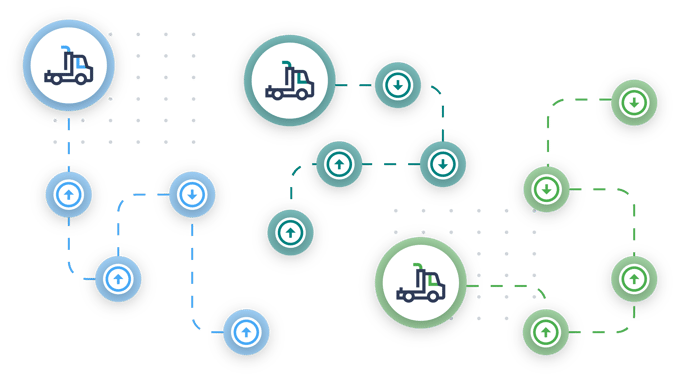
Route optimization involves four key steps: data collection, constraint identification, route generation, and continuous monitoring and adjustment. Advanced software solutions play a crucial role here, leveraging complex algorithms to analyze collected data, account for constraints, and generate optimized routes in real-time to adapt to changing conditions when needed.
If you want to understand the route optimization process, you’ll need to grasp the underlying mathematical models and optimization techniques. Each process begins with collecting and processing data – customer locations, vehicle capacities, time windows, traffic patterns, etc. This data is then processed through optimization algorithms that employ mathematical models to represent the problem as a series of equations and constraints.
The algorithms then systematically explore solutions, evaluating different route combinations and identifying the ones that best satisfy the specified objectives. This exploration process is computationally intensive and often involves constant refinement to find further optimized, more promising solutions for superior results.
Modern route optimization solutions leverage various techniques, like dynamic programming, that break down each problem into a series of smaller problems and combine solutions to determine an optimal solution. Then, real-time data integration and continuous monitoring enable you to adjust quickly and respond to external conditions like traffic delays or unexpected events.
Route optimization’s transformative power is evident in several real-world success stories across a wide range of industries. Here are some case studies that illustrate how businesses have leveraged advanced optimization techniques to overcome their various operational challenges, reduce costs, and enhance customer service:

With a network of over 6,000 power units and 20,000 trailers, Saia is one of the largest LTL carriers in the United States. In 2020, they decided to deploy RouteMax, a dynamic route optimization software designed to streamline and speed pickup and delivery operations.
By facilitating quick and accurate route building, the software empowers Saia's inbound planners to consistently meet service commitments while minimizing operational expenses across all 169 terminals. Rohit Lal, Saia’s executive vice president and Chief Information officer, says that “[they] recognized quite early that these tools gave [them] the ability to be more efficient and more productive” (Learn more).

Southeastern Freight Lines is a regional less-than-truckload carrier operating 89 service centers in 13 states, Canada, and Puerto Rico. They have roll out Optym's route planning solution across its network to improve the productivity of their planners and assets. The solution was customized to accommodate SELF's operations and helped them minimizing the number of vehicles needed for delivery and the number of likes travelled by those.
Woody Lovelance, SELF Senior Vice President & CIO, says that “RouteMax’s dynamic route optimization capabilities and intuitive workflows are helping [their] planners create more efficient routes in less time. As [they] continue our collaborations with Optym, we anticipate even greater success of RouteMax at SEFL"(Learn more).
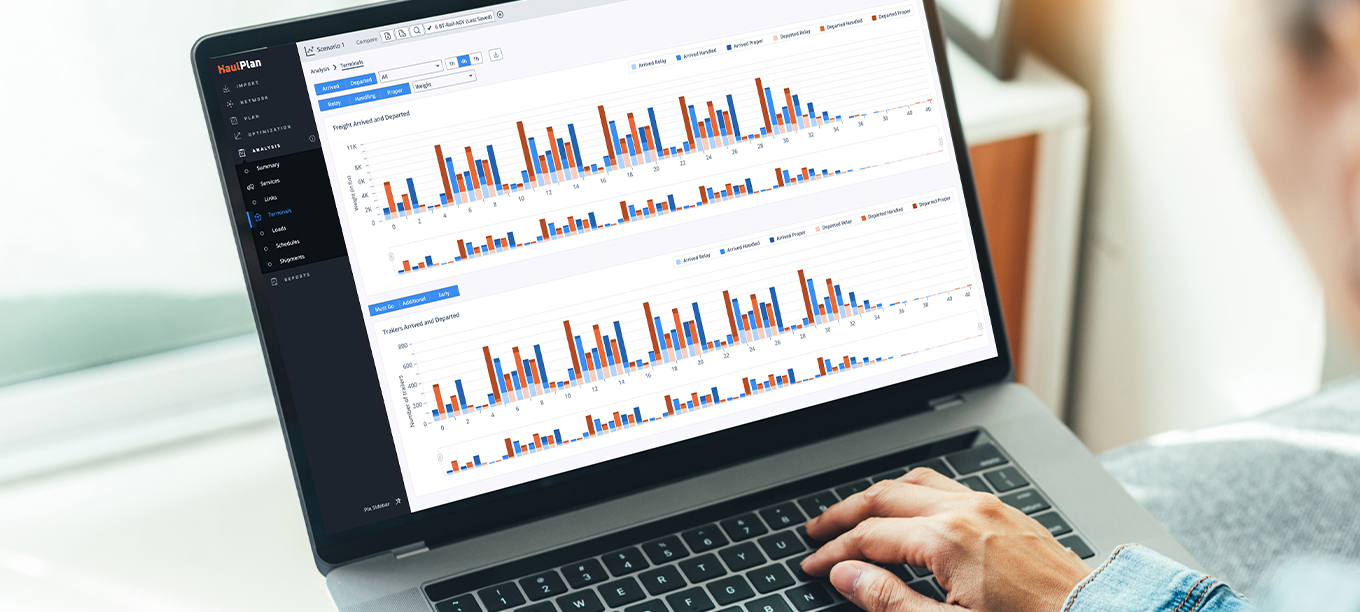
A leading transportation company wanted to reduce costs while maintaining service centers, but they were facing challenges to efficiently route shipments to avoid unnecessary rehandling at them. These rehandling continually added significant expenses and complexity to their operations.
The company implemented Optym's HaulPlan tool, a sophisticated solution that simulates freight movement and identifies optimization opportunities. By analyzing the network data and applying advanced algorithms, HaulPlan provided insights into rerouting strategies to minimize rehandling costs.
The solution proposed rerouting over 150 services to bypass a specific service center, shifting 72,000 pounds of freight daily. This move reduced terminal rehandling while maintaining service levels and ensuring a balanced approach to cost reduction and operational efficiency.
The results were impressive: the company achieved a remarkable $2,000 daily cost savings and eliminated 1,300 linehaul miles from its network. This initiative demonstrated the power of route optimization for identifying and implementing cost-effective strategies while ensuring seamless service delivery.
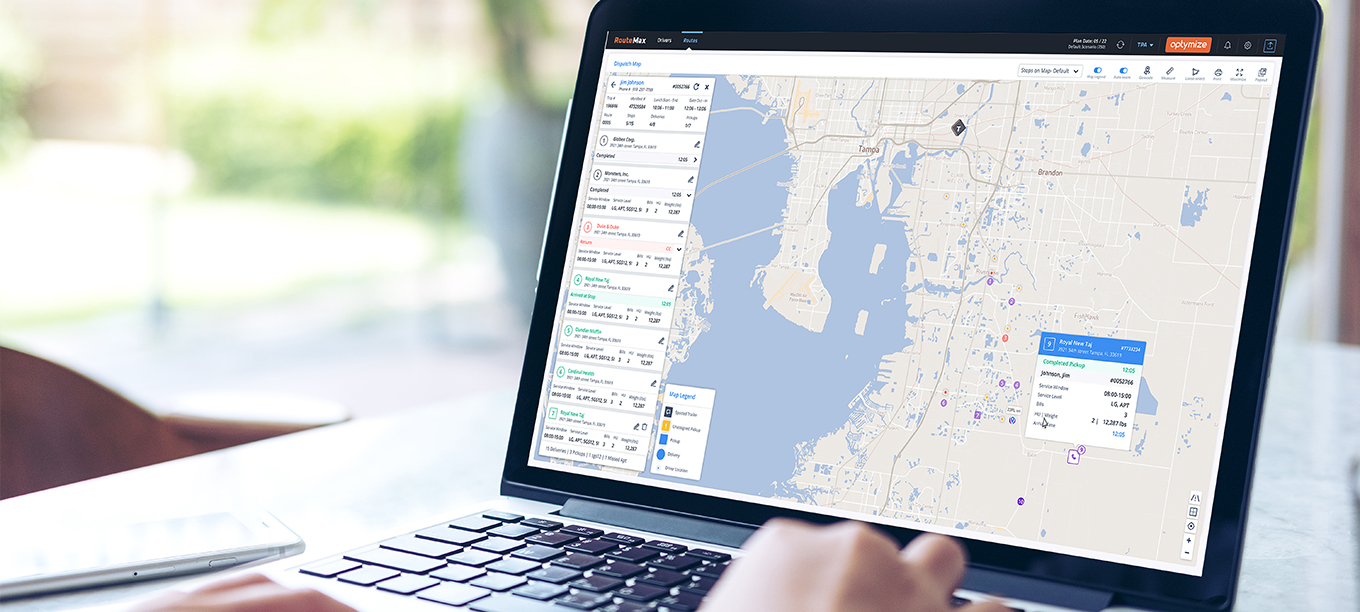
A regional less-than-truckload (LTL) carrier faced many difficulties in efficiently planning routes for its daily deliveries. Their time-consuming manual planning processes took hours to devise optimal routes and usually resulted in inefficiencies and suboptimal solutions.
To address this problem, the carrier utilized Optym's RouteMax solution, a cutting-edge route optimization software designed specifically for LTL carriers. RouteMax uses advanced algorithms and real-time data to generate optimized routes, considering various constraints like time windows, vehicle capacities, and driver availability.
When the carrier adopted RouteMax, it transformed its route planning process. The time it took to plan routes was reduced from hours to mere minutes, and
the carrier achieved a 6 percent decrease in miles per stop, an 8 percent increase in stops per hour, and a 50 percent reduction in route planning time. These improvements led to substantial cost savings, improved productivity, and enhanced customer service.
Both case studies show the tangible benefits your business could realize if you embrace route optimization solutions. Whether it’s reducing terminal rehandling costs or streamlining the route planning process, such routing strategies enable you to gain the competitive edge you need to improve your operations and drive long-term success and profitability.
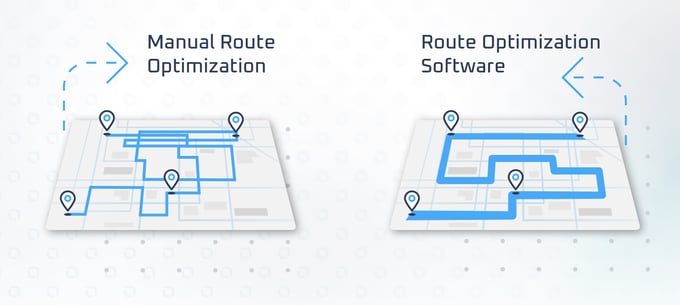
Manual route planning and consumer-grade navigation apps like Google Maps and Waze provide basic routing capabilities but fall short regarding the complex demands of modern transportation and logistics operations. If your business strives for efficiency and cost savings, the limitations of these traditional approaches will become increasingly apparent.
The real problem with these tools isn't in their accessibility – it's that they're not designed to handle the complexities of commercial delivery operations. In fact, they're primarily designed with personal use in mind. As such, these apps lack the advanced Optimization features your business needs and fail to account for a range of critical factors.
Additionally, these apps primarily focus on point-to-point navigation. They don't consider the intricacies of route optimization, making them unable to sequence multiple stops, handle load consolidation, or resource allocation. Thus, the routes they generate can sometimes lead to longer travel times, higher fuel consumption, and increased operational costs.
Routes completely designed by human planners are time-consuming and prone to error. This manual route planning process requires planners to consider countless variables – delivery locations, traffic patterns, vehicle capacities, etc. – that can quickly become overwhelming. It's even more apparent the larger the scale of your operation.
Some errors you’ll see most often include inefficient routing, increased costs, and dissatisfied customers due to missed delivery windows or delayed arrivals. These are entirely the result of human errors, as even the most experienced planners sometimes overlook critical factors, leading to suboptimal decisions.
Manual planning also lacks scalability, making it challenging for businesses looking to adapt to growth or demand fluctuations. As your number of deliveries and constraints increases, the complexity of your route planning grows exponentially, rendering traditional manual methods both inefficient and unsustainable.
As opposed to how manual planning and consumer-grade navigation apps handle route planning, dedicated route optimization software utilizes advanced technologies and algorithms to generate optimized routes tailored to the specific needs of delivery operations.
Route optimization software can handle larger data sets that incorporate information from various sources, such as customer orders, vehicle specifications, driver schedules, real-time traffic conditions, and more. By processing all this data through sophisticated algorithms, the software generates routes that account for the most complex constraints and objectives to maximize asset utilization, minimize travel time, and adhere to delivery time windows.
These software tools also employ advanced techniques like machine learning to refine and improve route plans continuously. This means it will explore numerous route permutations to identify the most efficient solutions that far exceed the capabilities of manual planning or consumer-grade navigation apps.
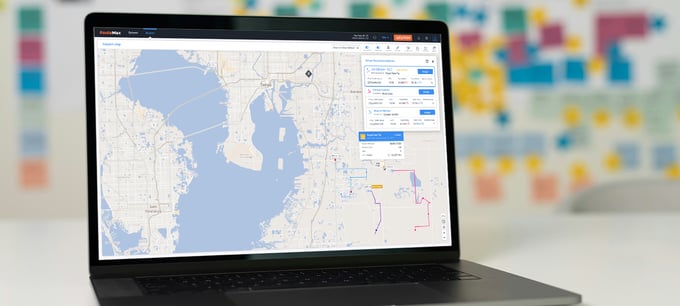
Route optimization software is a modern and powerful technological solution designed to streamline the routing and scheduling of delivery operations. By leveraging advanced data analytics, the software can generate efficient routes based on vast amounts of information. Routing software enables businesses to maximize productivity, reduce costs, and improve the customer experience.
At its core, route optimization software automates the more complex aspects of route planning by accounting for myriad factors that are nearly impossible to manage manually. By integrating data from various sources, the software can create routes that are guaranteed to minimize travel time, fuel consumption, and other operational costs.
|
Automatic Route Planning: The software uses advanced algorithms that enable automatically generated, optimized routes considering every possible factor. |

|
Real-Time Tracking and Updates: Through GPS and telematics systems integration, route optimization software tracks vehicle locations and adjusts routes dynamically in response to changing conditions. |
|
Constraint Handling: The software accommodates constraints like driver schedules, regulatory requirements, vehicle capacities, and more. This ensures any route generated is both feasible and compliant. |
|
Analytics & Reporting: The robust analytics and reporting capabilities included in route optimization software provide insights into route performance, cost savings, and areas for improvement to enable more data-driven decision-making. |

If your business implements route optimization software, you’ll unlock some key advantages:
Today’s customers expect timely and reliable deliveries. With a route planner app, you’ll improve Estimated Time of Arrival (ETA) accuracy by factoring in real-time data like traffic patterns, weather conditions, and other unexpected events. By delivering precisely according to the ETA, your business will improve its on-time delivery performance and generate higher customer satisfaction scores.
Route optimization software drives significant cost savings across various facets of your delivery operations:
If your business utilizes a quality route planner app, it’ll play a pivotal role in streamlining your operations and maximizing efficiency in these ways:
We’ve covered cost savings, customer satisfaction, and operational efficiency, but how else can route optimization software offer you advantages that contribute to business success?

There are many route-planning apps on the market, but selecting the right one for your business can take time and effort. Making the right choice is crucial if you want to ensure the software aligns with your specific needs, seamlessly integrates within your existing software ecosystem, and supports your long-term growth objectives.
If you’ve found potential software options that may align with your business needs, evaluate them based on these criteria:

As we’ve seen thus far, route planning software offers numerous benefits. However, implementing and leveraging it successfully can present certain challenges that businesses must be prepared to address:
One of the biggest challenges in route optimization revolves around the complexity of pickup and delivery operations, particularly in the LTL industry. These operations involve a range of intricate workflows, such as shipment planning, wave planning, driver assignments, and more, each with its own set of constraints and objectives.
The need for dynamic route optimization to accommodate real-time changes adds even further layers of complexity. LTL companies need effective route optimization solutions to handle these nuances and ensure their routes minimize travel time and distance while also accounting for the unique requirements of their pickup and delivery operations.
Any time you implement new technology, you'll run into resistance from stakeholders. Route optimization software is no exception. Overcoming this resistance to ensure user adoption can be challenging, as it involves changing long-standing established processes and workflows.
You'll need to ensure your change management strategies are practical and include comprehensive training programs to ensure everyone in your operation understands the capabilities and benefits of the new software. Addressing concerns and misconceptions about the latest software's impact on job security and workloads goes a long way toward alleviating resistance and fostering a culture that embraces technology for efficiency and growth.
These challenges may seem daunting initially, but they're surmountable with proper planning, execution, and a commitment to continuous improvement. Address your data quality issues, ensure seamless integration, and implement change management strategies to help your business overcome these obstacles. That way, you'll fully utilize the powers of route optimization software to drive operational excellence and sustained profitability.

Route optimization offers some proven ways for delivery operations to slash their costs. Savings appear in several significant ways:
![]() Fuel Efficiency: With optimized routes prioritizing shorter distances and minimized unnecessary engine idling times, you’ll see a direct minimization of fuel expenses. Fuel costs are a tremendous expense for any fleet-based business, so even a minor percentage reduction translates into significant savings.
Fuel Efficiency: With optimized routes prioritizing shorter distances and minimized unnecessary engine idling times, you’ll see a direct minimization of fuel expenses. Fuel costs are a tremendous expense for any fleet-based business, so even a minor percentage reduction translates into significant savings.
![]() Labor Cost Reduction: When your drivers can complete more deliveries within their regular shift hours, you'll cut down on overtime and the need to hire extra drivers. This means lower overall labor costs, typically one of the most significant expenditures for delivery-oriented enterprises. Plus, your drivers will be happier with less stressful workloads, which can boost driver retention.
Labor Cost Reduction: When your drivers can complete more deliveries within their regular shift hours, you'll cut down on overtime and the need to hire extra drivers. This means lower overall labor costs, typically one of the most significant expenditures for delivery-oriented enterprises. Plus, your drivers will be happier with less stressful workloads, which can boost driver retention.
![]() Vehicle Maintenance Savings: The less your vehicles travel, the less wear and tear they’ll endure. This translates directly into lower maintenance costs and longer vehicle lifespans. With optimized routes, you’ll defer expensive replacements and repairs and extend the value of your fleet investment.
Vehicle Maintenance Savings: The less your vehicles travel, the less wear and tear they’ll endure. This translates directly into lower maintenance costs and longer vehicle lifespans. With optimized routes, you’ll defer expensive replacements and repairs and extend the value of your fleet investment.
![]() Operational Efficiencies: Streamlining your routes streamlines everything else! You can expect less administrative overhead, decreased costly delays, and reduced risks of missed deliveries incurring penalties. If you eliminate these inefficiencies, your operation will run smoother as you better use resources to increase overall delivery capacity.
Operational Efficiencies: Streamlining your routes streamlines everything else! You can expect less administrative overhead, decreased costly delays, and reduced risks of missed deliveries incurring penalties. If you eliminate these inefficiencies, your operation will run smoother as you better use resources to increase overall delivery capacity.
The potential for cost savings is huge, but the specific return on investment (ROI) for route optimization differs between businesses. To understand the savings impact, you'll have to take into account how many vehicles you have, how complex your deliveries are, and how efficient you currently are. Fortunately, many software vendors provide ROI calculators or will consult with you to project potential savings based on your company's specific data.
Remember: route optimization isn't just about finding the shortest possible route. It's about triggering a ripple effect of cost reductions throughout your organization to boost your bottom line directly. It's a smart investment.

The business world is more environmentally conscious than ever. That's why every industry has begun prioritizing sustainability initiatives to protect the environment and reap the rewards from them. The transportation sector—especially the trucking industry—is known to contribute to greenhouse gas emissions. This is yet another area where route optimization can be a powerful tool, as it helps businesses demonstrably reduce their environmental impacts and contribute to a cleaner future.
Traditional delivery route planning has been inefficient for a long time, leading to unnecessary travel distances, excessive idling, and increased fuel consumption. These factors directly contribute to rising emissions levels and environmental pollution. With route optimization software employing sophisticated algorithms to plan delivery routes meticulously, it prioritizes essential factors like:
![]() Fewer miles traveled: A quality route planner app strategically maps the most efficient routes to reduce the total miles driven by your delivery vehicles significantly. You'll generate lower emissions and benefit from a smaller carbon footprint.
Fewer miles traveled: A quality route planner app strategically maps the most efficient routes to reduce the total miles driven by your delivery vehicles significantly. You'll generate lower emissions and benefit from a smaller carbon footprint.
 Reduced idle times: All those unnecessary stops and wait times are a thing of the past. You’ll curb your engine idling time and reduce the associated release of harmful pollutants.
Reduced idle times: All those unnecessary stops and wait times are a thing of the past. You’ll curb your engine idling time and reduce the associated release of harmful pollutants.
![]() Consolidated loads: Your routing software will intelligently group deliveries and maximize truck capacity, reducing the number of vehicles required to complete every assignment. This equates to fewer emissions in the short term and overall.
Consolidated loads: Your routing software will intelligently group deliveries and maximize truck capacity, reducing the number of vehicles required to complete every assignment. This equates to fewer emissions in the short term and overall.
Beyond the benefits of lowering fuel costs and improving the overall efficiency of your fleet, you'll also foster a positive brand image. Adhering to eco-friendly efforts strengthens your reputation for environmental responsibility, which can potentially attract environmentally conscious consumers and stakeholders.
As environmental regulations become more robust yearly, route optimization enables your business to comply with stricter emission standards and avoid costly penalties proactively. Your company can operate with greater confidence and transparency by reducing your environmental impact.

Route optimization involves planning the best possible route for deliveries or service calls, considering countless factors like distance, traffic, delivery time windows, etc. It's about finding the most efficient route while considering driver schedules, available hours, legal requirements, and more – not just figuring out the shortest distance between point A and point B.
Every new technology requires some effort to implement successfully, but route optimization software is designed with user-friendliness in mind. Some key considerations include:
Results will vary between organizations, but here’s a straightforward way to gauge your potential savings:
Optym’s cutting-edge optimization solutions, including HaulPlan and RouteMax, automate and streamline the complexities of your delivery operations from the ground up. Our goal is to help you simplify every operation step with leading AI tools that allow you seamlessly manage loads, assign drivers, increase pickup and delivery efficiency, and create dramatically better routes.
For more information on how your organization can improve operational efficiency and reduce costs through high-quality route optimization software, schedule a call with a member of the Optym team today.
In today's rapidly evolving transportation landscape, the efficiency and sustainability of fleet operations have never been more critical.
Read this post to learn how advanced optimization technologies are reducing emissions to empower sustainable trucking.
Learn how RouteMAX gives you the best routes instantly for pickup & delivery planning and keeps your customers happy.
Keep up to date with industry trends, news, and more.